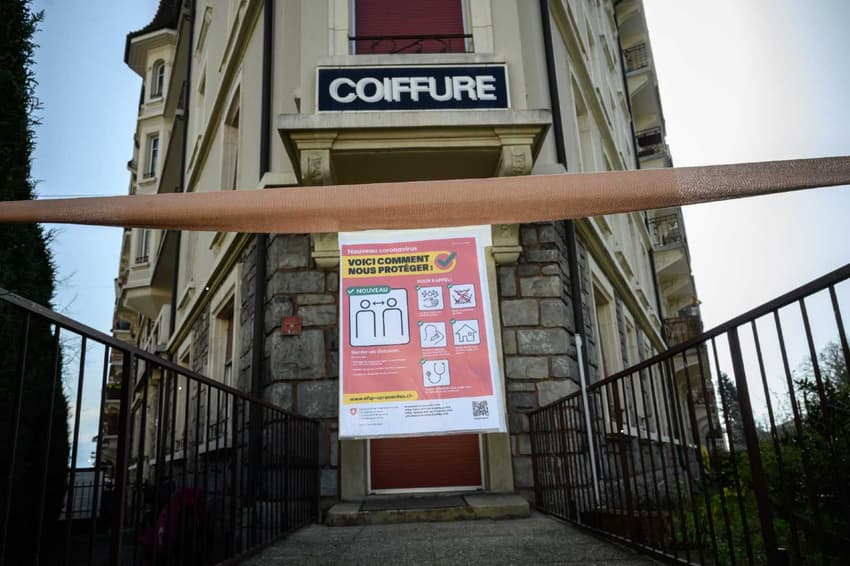EXPLAINED: Why does Switzerland have such a high rate of confirmed coronavirus cases per capita?

Switzerland has one of the highest rate of confirmed coronavirus infections on a per capita basis. Why is this the case?
On Wednesday, March 25th, Switzerland’s rate of 1,174 confirmed infections per one million people which for that day at least made it the country with the highest rate of infections on a per capita basis, overtaking Italy.
Italy - which also saw an increase on Wednesday - has 1,144 cases per million people.
Statistics are changing all the time but there's no hiding the fact Switzerland has a higher rate of confirmed coronavirus cases per capita than many countries.
Although it is difficult to definitively tell at this early stage, there are a number of possible reasons identified to explain the high rate of confirmed cases in Switzerland. .
Proximity
One major reason for Switzerland’s high rate of infection is simply proximity - in particularly, the country’s closeness to hard-hit northern Italy.
As of Wednesday morning, March 25th, the southern Swiss canton of Ticino - which shares a wide border and an intimate economic relationship with Italy - was the most heavily hit, with 53 deaths from the virus.
This amount is more than a third of the country's total death toll (133), despite the canton only having four percent of the Swiss population.
UPDATE: What you need to know about the coronavirus crisis in Switzerland
Ticino’s medical facilities were quickly overwhelmed - due largely to the canton’s small size - however efforts have been made to coordinate a Swiss-wide response in recent weeks.
Despite knowing of the threat of the virus early on, Swiss authorities were reluctant to close the border - fearing that doing so would cause more harm than good.
Approximately 68,000 cross-border workers came from northern Italy to Switzerland to work daily, including many in the healthcare sector.

Ski gondolas used as sidewalk cafe pods in Lausanne on March 21, 2020. Photo: FABRICE COFFRINI / AFP
However, proximity is not the only factor. While Ticino has a high death rate from the virus, the 1,211 confirmed infections in the southern canton is lower than that in the western cantons of Vaud (2,162) and Geneva (1,510).
Border controls
Switzerland is more heavily reliant than most nations on cross-border workers - a factor that is being exacerbated by border closures.
Despite some closures, the borders remain open in some areas for cross-border workers - although there are fears among Swiss medical authorities that neighbouring countries may at some point require that these medical staff refrain from crossing the borders and work in their country of residence.
Thierry Fumeaux, head of the intensive care unit at Vaud’s Nyon Hospital, told Welt: “It is clear that the loss of this foreign workforce would plunge Swiss hospitals into a crisis. We definitely have to prevent that."
Mask hysteria: Germany denies export ban despite blocking Swiss-bound medical supplies
Testing
Another factor, as reported in German media source Welt, is that Switzerland has a more extensive testing regime than many other affected countries, albeit not every suspected case in Switzerland is tested.
Only the United Arab Emirates, Norway and South Korea have tested more people per capita than Switzerland.
Initially Switzerland did not make testing the top priority in its strategy to contain the virus, believing it was too late as well as not wanting to overload hospitals.
The government stuck to a strategy of testing the most vulnerable patients and those with the most serious symptoms.
Initially Switzerland tested 2,500 cases a day but it is reported that is now up to 6,000 as certain cantons take it on themselves to boost testing.
On Thursday the central Swiss canton of Lucerne announced it would open the first drive-through testing centre for coronavirus in the country. A similar testing site in Bern is also earmarked, which could carry out 1,000 tests a day.
Slow to react?
Despite Switzerland being one of the first countries in the world to ban large group gatherings, some have criticised authorities for failing to adequately respond to the threat posed as the country’s ski season was in full flight.
The small canton of Graubünden, home to many of the country’s winter sports venues, has reported a higher than average infection and death rate than the Swiss national average.
Prior to ski activities ceasing in the country, a total of 10 percent of those who have died from the virus have died in Graubünden, despite the canton only having two percent of the country’s population.
Davos resident Liz Soguel told Global News on March 22nd that it was not until the middle of the month when the true nature of the threat was identified.
“Our public life has been shut down here, maybe a little too late,” she said.
“A lot of people here still led normal lives until this week. So many tourists were in town to go skiing. Everyone was moving around on crowded buses instead of staying home and socially distancing themselves.
“All the hotels were still full of tourists, though the ski hills had closed down.”
Comments (1)
See Also
On Wednesday, March 25th, Switzerland’s rate of 1,174 confirmed infections per one million people which for that day at least made it the country with the highest rate of infections on a per capita basis, overtaking Italy.
Italy - which also saw an increase on Wednesday - has 1,144 cases per million people.
Statistics are changing all the time but there's no hiding the fact Switzerland has a higher rate of confirmed coronavirus cases per capita than many countries.
Although it is difficult to definitively tell at this early stage, there are a number of possible reasons identified to explain the high rate of confirmed cases in Switzerland. .
Proximity
One major reason for Switzerland’s high rate of infection is simply proximity - in particularly, the country’s closeness to hard-hit northern Italy.
As of Wednesday morning, March 25th, the southern Swiss canton of Ticino - which shares a wide border and an intimate economic relationship with Italy - was the most heavily hit, with 53 deaths from the virus.
This amount is more than a third of the country's total death toll (133), despite the canton only having four percent of the Swiss population.
UPDATE: What you need to know about the coronavirus crisis in Switzerland
Ticino’s medical facilities were quickly overwhelmed - due largely to the canton’s small size - however efforts have been made to coordinate a Swiss-wide response in recent weeks.
Despite knowing of the threat of the virus early on, Swiss authorities were reluctant to close the border - fearing that doing so would cause more harm than good.
Approximately 68,000 cross-border workers came from northern Italy to Switzerland to work daily, including many in the healthcare sector.

Ski gondolas used as sidewalk cafe pods in Lausanne on March 21, 2020. Photo: FABRICE COFFRINI / AFP
However, proximity is not the only factor. While Ticino has a high death rate from the virus, the 1,211 confirmed infections in the southern canton is lower than that in the western cantons of Vaud (2,162) and Geneva (1,510).
Border controls
Switzerland is more heavily reliant than most nations on cross-border workers - a factor that is being exacerbated by border closures.
Despite some closures, the borders remain open in some areas for cross-border workers - although there are fears among Swiss medical authorities that neighbouring countries may at some point require that these medical staff refrain from crossing the borders and work in their country of residence.
Thierry Fumeaux, head of the intensive care unit at Vaud’s Nyon Hospital, told Welt: “It is clear that the loss of this foreign workforce would plunge Swiss hospitals into a crisis. We definitely have to prevent that."
Mask hysteria: Germany denies export ban despite blocking Swiss-bound medical supplies
Testing
Another factor, as reported in German media source Welt, is that Switzerland has a more extensive testing regime than many other affected countries, albeit not every suspected case in Switzerland is tested.
Only the United Arab Emirates, Norway and South Korea have tested more people per capita than Switzerland.
Initially Switzerland did not make testing the top priority in its strategy to contain the virus, believing it was too late as well as not wanting to overload hospitals.
The government stuck to a strategy of testing the most vulnerable patients and those with the most serious symptoms.
Initially Switzerland tested 2,500 cases a day but it is reported that is now up to 6,000 as certain cantons take it on themselves to boost testing.
On Thursday the central Swiss canton of Lucerne announced it would open the first drive-through testing centre for coronavirus in the country. A similar testing site in Bern is also earmarked, which could carry out 1,000 tests a day.
Slow to react?
Despite Switzerland being one of the first countries in the world to ban large group gatherings, some have criticised authorities for failing to adequately respond to the threat posed as the country’s ski season was in full flight.
The small canton of Graubünden, home to many of the country’s winter sports venues, has reported a higher than average infection and death rate than the Swiss national average.
Prior to ski activities ceasing in the country, a total of 10 percent of those who have died from the virus have died in Graubünden, despite the canton only having two percent of the country’s population.
Davos resident Liz Soguel told Global News on March 22nd that it was not until the middle of the month when the true nature of the threat was identified.
“Our public life has been shut down here, maybe a little too late,” she said.
“A lot of people here still led normal lives until this week. So many tourists were in town to go skiing. Everyone was moving around on crowded buses instead of staying home and socially distancing themselves.
“All the hotels were still full of tourists, though the ski hills had closed down.”
Join the conversation in our comments section below. Share your own views and experience and if you have a question or suggestion for our journalists then email us at [email protected].
Please keep comments civil, constructive and on topic – and make sure to read our terms of use before getting involved.
Please log in here to leave a comment.